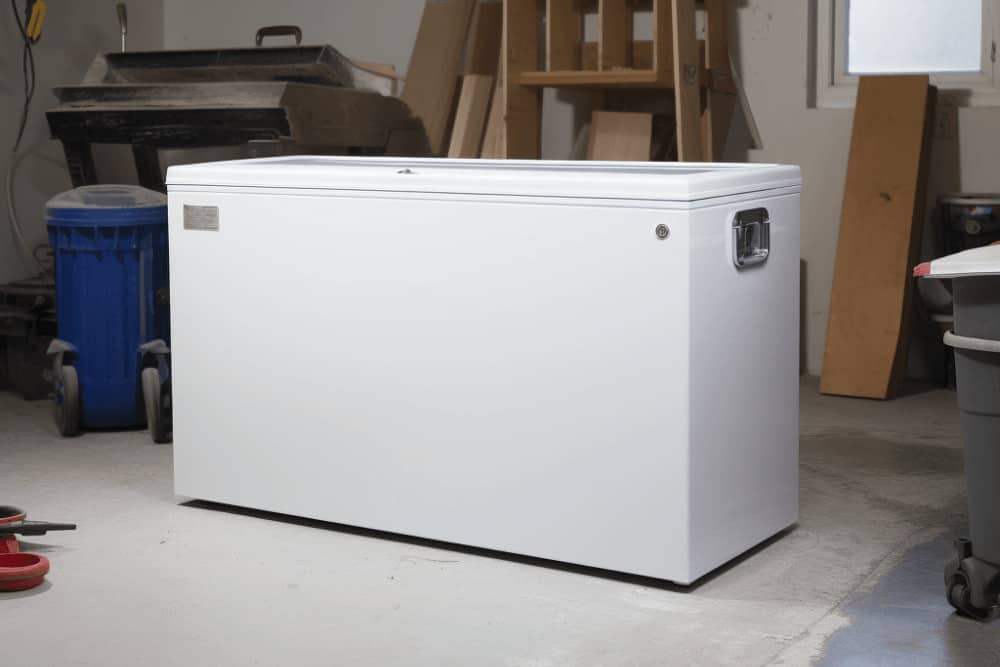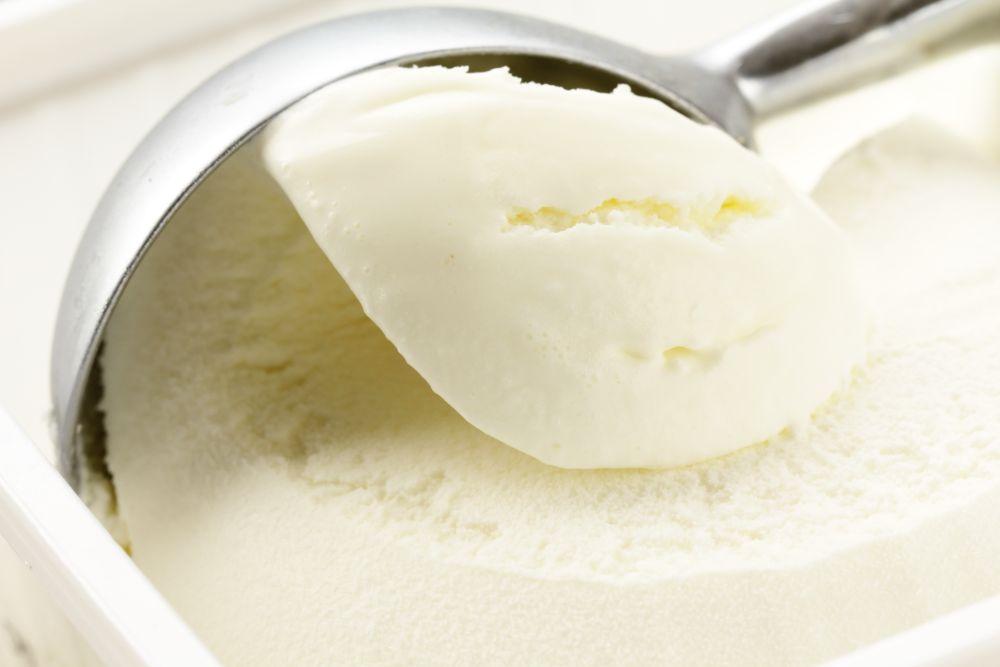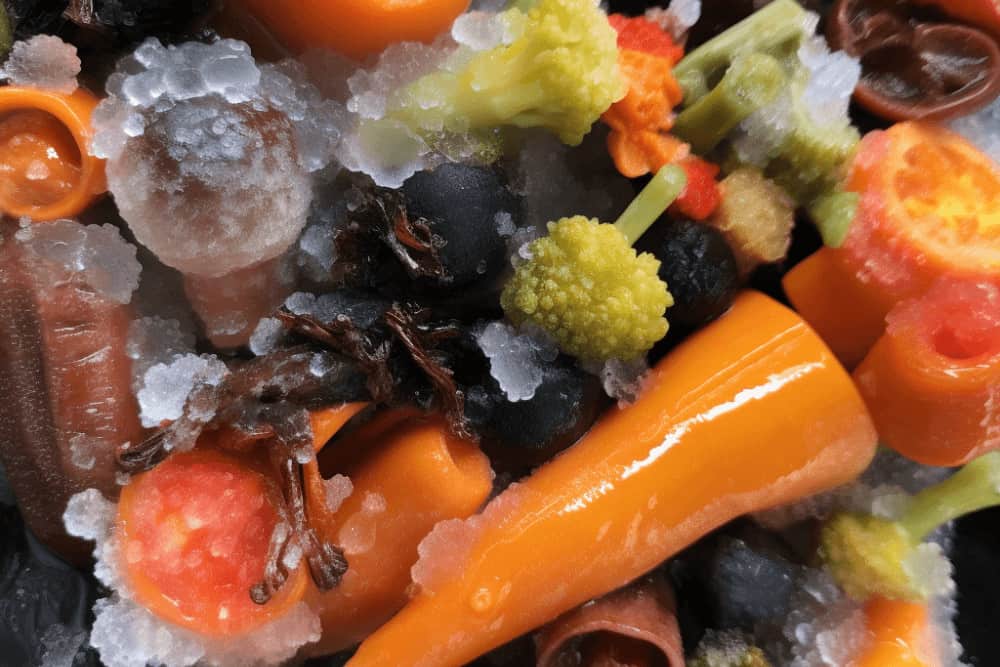Note that the term “deep freezer” applies to both a chest freezer and an upright freezer - both are deep freezers. A deep freezer is an appliance that is dedicated solely to freezing food - unlike a fridge freezer combo. That said the best freezer temp will also apply to these fridge freezer combo units.
Finding the best temperature for your deep freezer is crucial. It helps you keep your food safe and preserves its quality. In this article, we'll explore the recommended temperature and some factors to consider.
The FDA recommends a deep freezer be set at a temperature of 0°F (-18°C). This cold setting ensures your food stays frozen and prevents spoilage. However, your specific freezer might need adjustments depending on factors we'll discuss.
Note that this is a significantly colder temperature than not only your FDA recommended refrigerator temperature (below 40°F), but it is also well below the freezing point of water (32°F).

The proper Temperature for That Chest Freezer in Your Garage is Zero Degrees Fahrenheit
Now that you know the ideal freezer temperature, it's time to fine-tune your deep freezer. By understanding its environment and usage, you can achieve optimal performance and safeguard your food.
Let's dive in!
When it comes to selecting the right temperature for your deep freezer, it's key to consider the types of food you want to store. The ideal temperature range for a deep freezer is at or below 0°F (-18°C).
This temperature ensures that the food you keep inside remains frozen and safe to eat.
Matt From Don’s Appliances Discusses Freezer Temperatures and How Freezer Alarms Can Help Prevent Freezer Burn and Food Spoilage
If you frequently store ice cream, you may want to adjust your freezer's temperature. The best temperature range for scooping ice cream is 6°F to 10°F.
However, for long-term storage, 0°F is the recommended temperature. Long term storage of ice cream above 0°F can lead to the formation of ice crystals and freezer burn.
Take note that the environment around your freezer can affect its temperature settings. Keep an eye on the temperature and adjust it as necessary to maintain the recommended 0°F.
Here are a few general guidelines on temperature storage for various frozen foods - :
With these temperature tips, your frozen food will stay safe, fresh, and ready to enjoy whenever you want. Remember to keep your freezer's temperature within the recommended range and adjust it as necessary.

Ice Cream is Best Scooped at Temperatures a Bit Higher Than Zero Degrees (around 5-8 Degrees Fahrenheit is ideal), but You Shouldn’t Store it at any Temperature Warmer than 0 degrees.
In this article, we discuss various factors that affect the ideal temperature for your deep freezer. Consider the following elements when setting your freezer's temperature:
Think about the types of food you store in your freezer. Different food items may require distinct temperatures to preserve their quality and taste.
For example, ice cream may need a slightly lower temperature than frozen vegetables.
Ensure that you're storing food items correctly at the recommended temperature to keep them safe and fresh for consumption.
Freezer Capacity and Efficiency
Keep in mind that a fuller freezer tends to be more energy-efficient. This is because the cold air doesn't need to circulate as much, helping maintain consistent temperatures.
However, avoid overpacking your freezer; this may obstruct airflow and cause uneven temperatures. Aim to strike a balance between the capacity and efficiency of your freezer.
Climate and Location
Climate and other environmental factors may impact your deep freezer's performance. If you live in a humid or hot area, your freezer may need to work harder to maintain low temperatures.
Similarly, placing your freezer near heat-generating appliances or direct sunlight could affect its efficiency. Adjust your freezer's temperature settings accordingly to account for external influences.
Maintaining the optimal temperature in your deep freezer is crucial for food safety and preserving the quality of your frozen items. This section offers practical tips to help you ensure that your deep freezer stays at the ideal temperature of 0°F (-18°C) or below.

Chest Freezers are More Efficient from an Energy Consumption Standpoint Than Upright Freezers - Cold Air Tends to Stay in Place at the Bottom of a Chest Freezer. Warm Air Can More Easily Find its Way into an Upright Freezer
It's essential to monitor the temperature of your deep freezer regularly. Invest in a reliable appliance thermometer and place it in an easily visible spot inside your freezer.
Check the temperature periodically, and adjust the settings if needed.
Proper loading and storage play a key role in maintaining the ideal temperature. Keep these tips in mind:
To maintain long-lasting and efficient freezing, be sure to perform regular maintenance on your deep freezer. Keep these guidelines in mind:
By following these simple tips, you can easily maintain the optimal temperature in your deep freezer and ensure that your food remains safe and tasty for an extended period.
When it comes to your deep freezer, energy efficiency plays a vital role. By ensuring the optimal temperature, you can save money and help protect the environment.
Let's delve into some vital points to consider when seeking efficiency and cost savings.
First off, find the right temperature for your deep freezer. The ENERGY STAR recommends setting your freezer at 0 degrees Fahrenheit. Keeping a stable temp means less energy is wasted to maintain the cold.
Next, consider ENERGY STAR-certified freezers. They use at least 10% less energy than non-certified ones.
In fact, an ENERGY STAR chest freezer can save you about $30 per year, while an upright model saves around $50 per year.
Here are some more tips to maximize your deep freezer's energy efficiency:
There you have it! By following these guidelines, you'll not only improve your freezer's energy efficiency but also save money on your energy bills. Happy freezing!
When managing your deep freezer, always prioritize safety. Begin by setting the right temperature.
Check your surroundings: Ensure your workspace is clutter-free, especially around the freezer to avoid accidents.
Working in a cold storage environment might expose you to cold stress. Always wear appropriate personal protective equipment (PPE) to protect yourself from frostbite, hypothermia, and other cold-related issues.
Remember to assess your workspace for any potential hazards and address them promptly.
When adjusting your deep freezer's temperature, keep in mind that a lower number usually indicates a warmer setting, while a higher number means a colder temperature.
In this case, 7 would be colder than 1. It is vital to refer to your specific freezer's manual for its temperature settings and adjustment instructions.
If your freezer is too cold, ice can quickly build up, causing the freezer to use more energy and overwork the compressor.
To check if your freezer is too cold, place a thermometer inside and compare the reading to the recommended 0°F (-18°C) temperature. If it is significantly lower, adjust the temperature settings accordingly to avoid potential issues.
When your food isn’t properly stored in the freezer, it can lead to the food dehydrating and oxidizing due to the frozen food coming into contact with the surrounding air. This can also be caused by a freezer that isn’t at the optimal temperature - or a freezer that has frequent wide ranging temperature fluctuation.
This can result in major food waste.
While food that has freezer burn isn’t dangerous to eat, but it will taste “off” as the texture and flavor of the food have been ruined. Freezer burn is a major contributor to food spoilage. You can avoid freezer burn through proper food storage.

Freezer Burned Vegetables May Not Make You Sick, But They Certainly Don't Taste Very Good
Make sure to tightly wrap food, place it in an airtight container, and store it in a freezer that is consistently set at the correct temperature of zero degrees Fahrenheit. Make sure that you have a freezer thermometer to monitor and maintain that low temperature in your deep freezer.
